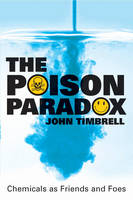
The Poison Paradox
Oxford University Press (Verlag)
978-0-19-280495-2 (ISBN)
- Titel ist leider vergriffen;
keine Neuauflage - Artikel merken
Every day we are surrounded by chemicals that are potentially harmful. Some of these we take intentionally in the form of drugs; some we take unknowingly through the food we eat, and the environment around us. John Timbrell explores what makes particular chemicals harmful, what their effects are, and how we can test for them. He examines drugs such as Paracetamol and what it does to the body; Ricin, the most toxic substance known to man; Paraquat, a widely available weedkiller; and how the puffer fish, eaten as a delicacy in Japan, can kill. Using case studies from all around the world, such as the Spanish Oil syndrome which made over 20,000 people ill in Madrid, Timbrell uncovers the facts behind chemical scares. He shows how, with a rational, scientific, and balanced approach, risks can be assessed and managed safely.
John Timbrell is Professor of Biochemical Toxicology in the Department of Pharmacy, King's College, London. He is the author of two successful toxicology textbooks (Taylor and Francis) and the editor of a major journal. This will be his first publication for a general audience.
1. Old art, new science: Introduction to toxicology; 2. What chemicals do to us and what our bodies do to them: The principles of toxicology; 3. Keep taking the medicine, "But is it safe Doctor?": chemicals we deliberately swallow; 4. Blood, sweat, and tears: Pesticides, poisons man has designed; 5. First the cats died: Environmental contaminants; 6. Natural born killers: Chemicals nature designs to be poisonous; 7. The Mad Hatter and a bad case of acne: Industrial chemicals; 8. Under the sink and in the shed: Household poisons; 9. Rasputin's revenge: Chemicals used to kill; 10. Ginger Jake and Spanish oil: Food contaminants and additives; 11. A risky business: The assessment of risk from chemicals; Glossary; Bibliography; Index
| Erscheint lt. Verlag | 30.6.2005 |
|---|---|
| Zusatzinfo | numerous b/w line, halftones, b/w plates |
| Verlagsort | Oxford |
| Sprache | englisch |
| Maße | 163 x 242 mm |
| Gewicht | 696 g |
| Themenwelt | Sachbuch/Ratgeber ► Natur / Technik ► Naturwissenschaft |
| Studium ► 2. Studienabschnitt (Klinik) ► Pharmakologie / Toxikologie | |
| ISBN-10 | 0-19-280495-2 / 0192804952 |
| ISBN-13 | 978-0-19-280495-2 / 9780192804952 |
| Zustand | Neuware |
| Haben Sie eine Frage zum Produkt? |
aus dem Bereich


